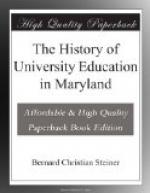The Rev. William Du Bourg, the President, was a man of great ability and the reputation of the College rapidly spread. Many prominent men, Roman Catholics and Protestants, were graduated from St. Mary’s; but the Sulpicians felt that their vocation was to educate young men exclusively for the priesthood, and not for secular life, and they finally closed St. Mary’s College in 1852, in order to devote all their energies to the Theological Seminary, which has continued its prosperous career to this present day.[47]
A second Roman Catholic College was formed by the Sulpicians in 1807 at Emmittsburg, Frederick County. It was begun by Rev. John Dubois and was soon chartered as Mount Saint Mary’s College. The exercises were first held in a log house with a handful of pupils, who increased to 80 within five years. With the growth of the institution came the demand for larger accommodations. Better buildings were erected and a large stone edifice was undertaken in 1823. When nearly ready for occupancy, it was destroyed by fire; but Father Dubois did not despair and, aided by the people of the vicinity, at once began a new building. In 1826 he was appointed Bishop of New York, and in the same year, the connection of the College with the Sulpician order was terminated. Although originally intended chiefly as a place for the education of clerics, Mt. St. Mary’s has ever kept in view the preparation of students for a secular life, and many of its graduates have been distinguished in State, as well as in Church. In 1838, Rev. John McCaffrey, D.D., became president, and under his able control, the College prospered until 1871. During this period, the jubilee of the institution was celebrated with great ceremony in 1858. The Civil War injured the College greatly and the declaration of peace found it burdened with a heavy load of debt. For twenty years the struggle went on and it was doubtful all the time, whether the College could survive. Finally Dr. William Bryne, at his leaving the presidency in 1884, was able to report that the institution was placed on a firm financial basis as to the future, and that the debt had been reduced to $65,000. The present President, Rev. Edward P. Allen, has still further diminished the debt by more than half and the attendance has been largely increased through his efficient administration.
A third Roman Catholic College is St. Charles’s, situated in Howard County, near Ellicott City. It is situated on land given by Charles Carroll of Carroll ton, and was chartered on February 3, 1830,[48] its name being taken from that of its founder and of the great Archbishop of Milan.[49] The institution was placed under the control of the Society of St. Sulpice and was established “exclusively for the education of pious young men of the Catholic persuasion for the ministry of the Gospel.” The corner-stone was laid by the venerable Charles Carroll, on July 11, 1831; but, for want of funds to carry on the work successfully, the institution was not opened until the fall of 1848. The first President, Rev. O.L. Jenkins, began the institution with four pupils, and at his death in 1869, the number had grown to 140. Since the closing of St. Mary’s College in 1852, St. Charles’s has been used by the Sulpicians as preparatory to St. Mary’s Seminary.




